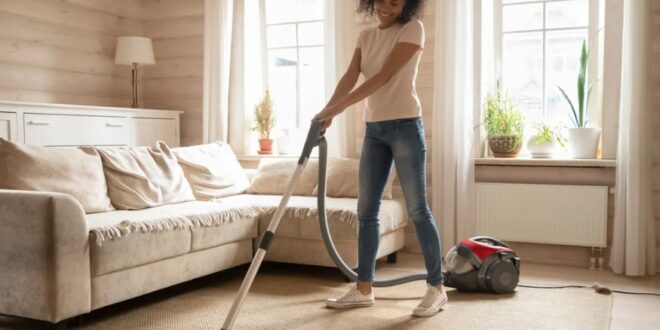A clean home is a healthy home. Discover 6 cleaning strategies for a healthier home. Regular cleaning and maintenance not only keep your living space looking and smelling fresh but also prevent the buildup of harmful bacteria and allergens that can negatively impact your health.
In fact, studies show that indoor air can be up to five times more polluted than outdoor air, making it critical to prioritize cleanliness in your home.
If you are living in Cyberjaya, Malaysia, you can hire a cleaning service in Cyberjaya with a good track record to do all the tedious and dirty cleaning tasks for you.
The Importance of Maintaining a Clean and Healthy Home
When you live in a clean environment, you feel better both physically and mentally. A tidy home is visually pleasing and promotes feelings of calmness and relaxation.
It also reduces stress levels by eliminating visual clutter that can cause distractions or anxiety. But beyond the mental benefits, maintaining a clean home is essential to staying healthy.
Dust, pet dander, mold spores, and other allergens can accumulate quickly if left unchecked. They can trigger allergies or asthma attacks in those who are sensitive, causing respiratory problems such as coughing or wheezing.
Additionally, bacteria and viruses thrive in dirty environments. The flu virus, for example, can survive on surfaces for up to 48 hours after being deposited by an infected person.
An Overview of the 6 Cleaning Strategies

Maintaining a clean and healthy home environment requires adopting effective cleaning strategies that address all areas of your living space: from the floors to the air you breathe. There are six key strategies that will help you keep your living space clean and healthy:
- Regular cleaning schedule ─ establishing a consistent cleaning routine helps keep dirt at bay while allowing you to stay on top of household tasks without feeling overwhelmed.
- Green cleaning products ─ switching from traditional cleaning products to environmentally friendly alternatives can help you reduce your exposure to harsh chemicals and protect the environment.
- Deep cleaning techniques ─ besides regular cleaning, deep cleaning periodically can help eliminate stubborn stains, grime, and bacteria that accumulate over time.
- Air quality improvement ─ Poor air quality in the home can lead to health problems such as allergies or respiratory issues. Improving air quality is essential for maintaining a healthy living space.
- Decluttering ─ A cluttered environment can cause stress and anxiety and may even impact your mental health. Decluttering allows you to create a more organized living space that promotes relaxation and calmness.
- Regular мaintenance ─ keeping up with maintenance tasks such as changing air filters or servicing appliances helps ensure that everything in your home is functioning properly and reduces the likelihood of breakdowns or costly repairs down the line.
By following these best practices for maintaining a clean and healthy home environment, you will be able to enjoy all the benefits of a tidy living space without sacrificing your health.
The Importance of a Regular Cleaning Schedule
Maintaining a clean and healthy home is crucial for the well-being of you and your family. One of the most effective ways to achieve this is by establishing a regular cleaning schedule.
The benefits of having a consistent cleaning routine are numerous, ranging from reducing the likelihood of allergies and illnesses to enhancing mental clarity and productivity. By sticking to a specific cleaning schedule, you can ensure that your home is always in pristine condition.
With regular dusting, vacuuming, and wiping down surfaces, you can greatly reduce the amount of allergens in the air. This can be especially helpful for individuals who suffer from allergies or asthma-related issues.
Furthermore, keeping your living space clean can positively impact your mental state. Studies have shown that an organized environment has been linked to increased productivity and reduced stress levels.
Strategy 1 ─ Tips for Creating a Cleaning Schedule That Works
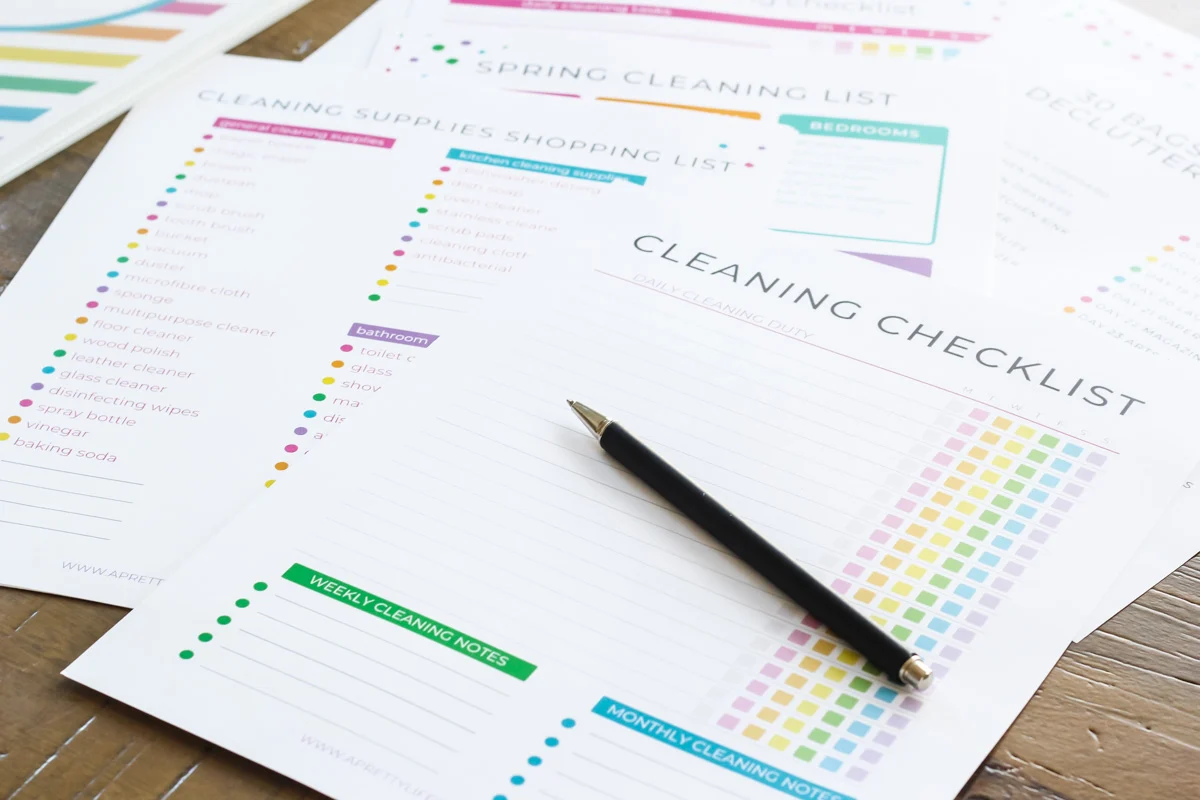
Creating a cleaning schedule may seem overwhelming at first, but it doesn’t have to be. Here are some tips on how to establish a routine that works for you:
- Break down tasks into manageable chunks ─ Don’t try to tackle everything at once; instead, break down cleaning tasks into smaller sections and assign them to different days or times throughout the week.
- Prioritize certain areas ─ Focus on high-traffic areas such as kitchens and bathrooms first since these tend to get dirtier more quickly.
- Involve household members ─ If possible, involve other household members in the cleaning process by assigning specific tasks or creating a chore chart.
- Be realistic ─ Don’t set unrealistic expectations for yourself; create a schedule that is manageable based on your lifestyle.
- Adjust as necessary ─ As your needs change over time (i.e., new additions to the household), be sure to adjust your cleaning schedule accordingly so that it continues to work effectively.
Establishing a regular cleaning schedule is an essential component of maintaining a healthy and happy home. By following the tips above, you can create a cleaning routine that works for you and your household.
The Benefits of Green Cleaning Products
Cleaning is essential, but not all cleaning products are created equal. Many traditional cleaning products contain harmful chemicals that can cause serious health problems, such as respiratory issues and skin irritation, both for the user and their pets.
Traditional cleaning products also contribute to environmental pollution. Green cleaning products offer a safer alternative.
They are made from natural, non-toxic ingredients that do not pose any harm to the user or the environment. Using green cleaning products can help reduce your carbon footprint and make your home a healthier place to live in.
Strategy 2 ─ Effective Green Cleaning Products and Their Uses
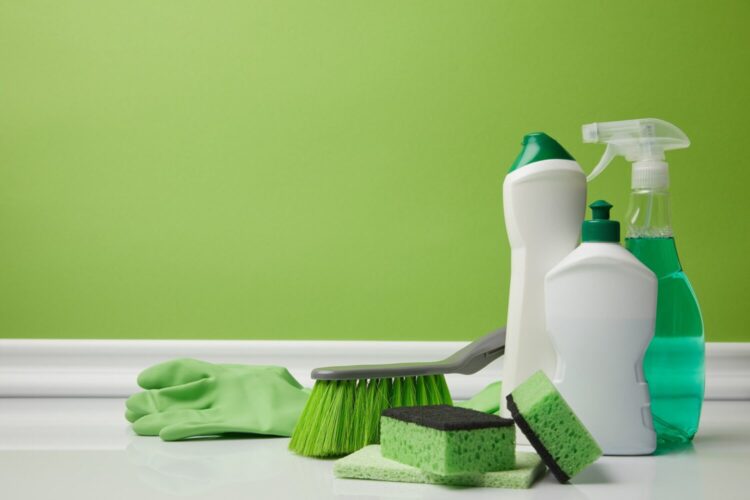
There are many green cleaning products available on the market today, but not all of them are created equal. Here are some effective green cleaning products that you can use in your home:
Vinegar
Vinegar is an excellent multi-purpose cleaner for many surfaces in your home. It’s a natural disinfectant and can effectively clean kitchen counters, floors, windows, and bathroom tiles. Mix one part vinegar with one part water in a spray bottle to create an effective solution.
Baking Soda
Baking soda is another versatile natural cleaner that has deodorizing properties as well as mild abrasive properties that make it ideal for scrubbing sinks, showers, toilets, and other surfaces needing a thorough cleaning.
Lemon Juice
Lemon juice is an excellent natural bleach that can be used to remove stains from clothing or whiten grout lines in tiled floors or showers. These are just three examples of green cleaning product options available – there are many more on the market today!
Make sure you always read product labels carefully before buying any cleaner – they should clearly indicate what harmful chemicals have been omitted from the formula and which remaining ingredients have been used instead. Remember – when it comes to protecting our health and the environment, choosing green cleaning products is a wise choice.
Strategy 3 ─ Deep Cleaning Techniques
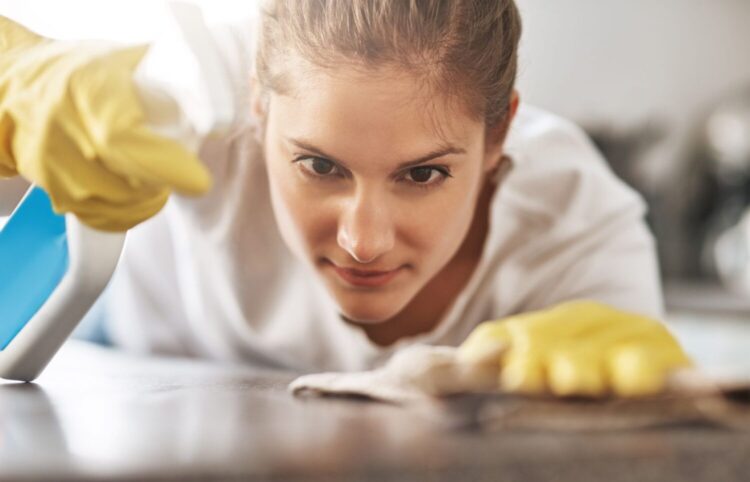
What is Deep Cleaning and Why Is It Important?
Deep cleaning goes beyond your usual cleaning routine, targeting areas that are often overlooked in day-to-day cleaning. This includes areas such as baseboards, grout, and behind appliances.
Deep cleaning is important because it not only improves the appearance of your home but also removes harmful bacteria and allergens that can cause health problems. Over time, dirt and grime can build up in hidden areas of your home.
If left unattended, this can create an unhealthy environment for you and your family. By deep cleaning regularly, you remove these harmful particles, improving the air quality of your home and reducing the risk of allergies or respiratory issues.
Step-by-Step Guide to Deep Cleaning Various Areas in Your Home
When it comes to deep cleaning, each area of your home requires different techniques and tools to ensure a thorough clean. Here are some step-by-step guides for deep cleaning various areas in your home:
Kitchen Appliances:
- Unplug all appliances before starting.
- Remove any loose parts or accessories (such as shelves or drawers).
- Wash all removable parts with warm soapy water.
- Wipe down the exterior of each appliance with a damp cloth.
- Use a degreaser or vinegar solution to clean tough stains on stovetops or ovens.
- Clean the inside of the fridge with warm soapy water.
- Dry all surfaces before reassembling.
Carpets:
- Vacuum thoroughly to remove dust and debris.
- Spot clean any visible stains with a carpet cleaner solution.
- Use a steam cleaner for an overall deep clean of carpets.
- Move furniture out of the way to get access to all areas that need cleaning.
- Allow the carpet to dry completely before placing the furniture back.
Bathrooms:
- Remove all items from the bathroom, including shower curtains, bath mats, and towels.
- Spray all surfaces with a cleaning solution and let it sit for a few minutes.
- Scrub tiles and grout with a brush or toothbrush.
- Clean the toilet bowl with a toilet cleaner and scrub thoroughly.
- Use vinegar to clean showerheads and faucets, removing any buildup of minerals.
- Replace towels, mats, and shower curtains once everything is dry.
By following these step-by-step guides for deep cleaning various areas in your home, you can create a cleaner, healthier living environment for you and your family. Don’t forget to deep clean regularly to maintain this healthy home!
Strategy 4 ─ Air Quality Improvement
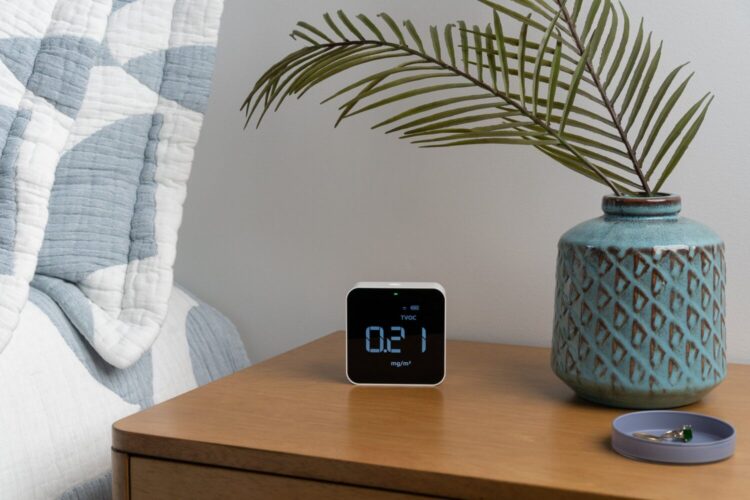
The Dangers of Poor Air Quality
Air pollution is not only a problem when you’re outside. Indoor air pollution can be two to five times worse than outdoor air pollution, according to the U.S. Environmental Protection Agency (EPA). Poor indoor air quality can lead to health problems such as headaches, fatigue, respiratory issues and even cancer.
In fact, the EPA has ranked indoor air pollution as one of the top five environmental dangers that people face every day. Poor air quality is particularly dangerous for children and people with pre-existing health conditions like asthma or heart disease.
Long-term exposure to indoor pollutants such as chemicals, dust mites and mold can lead to serious health issues later in life. Therefore, it is important to be proactive about improving your home’s air quality.
Tips for Improving Air Quality in Your Home
Improving the air quality in your home is not as difficult as you might think. Here are some tips:
- Use an air purifier ─ Air purifiers work by filtering out pollutants from the air using high-efficiency particulate air (HEPA) filters or other specialized filters that trap tiny particles like pollen, dust mites and pet dander. This can help reduce allergy symptoms and improve overall respiratory health.
- Open windows regularly ─ This one is simple but effective! Fresh outdoor air helps dilute and remove pollutants from inside your home.
- Monitor humidity levels ─ Keep an eye on humidity levels (between 30% to 50% is ideal) since high humidity creates a breeding ground for mold and mildew which take a toll on respiratory health.
- Avoid smoking indoors ─ Smoking releases harmful chemicals including carbon monoxide into the indoor environment which increases the risk of lung cancer among other diseases.
Improving your home’s indoor air quality through the aforementioned methods is important for your overall health and comfort. By utilizing these tips, you can breathe easier and maintain a healthier home environment.
Strategy 5 ─ Decluttering

Clearing the Mind by Clearing the Clutter
Decluttering your home does not just make it look cleaner and more organized – it can also have a positive impact on your mental health.
According to a study conducted by UCLA’s Center on Everyday Lives and Families, women who described their homes as cluttered had higher levels of cortisol, a stress hormone, than women who felt their homes were restful and restorative.
In addition to causing stress and anxiety, clutter can also contribute to feelings of overwhelm and lack of control. So how do you begin decluttering?
It can be overwhelming to tackle an entire house at once, so start small with one specific area in your home. For example, choose one closet or drawer that needs attention.
Begin by taking everything out of that space and sorting items into three categories: keep, donate/sell, or toss. Be honest with yourself – if you haven’t used an item in over a year or it doesn’t bring you joy anymore, it’s probably time to let go.
Tips for Tackling Different Areas
Decluttering techniques can vary depending on the type of space you are tackling. Here are some tips for decluttering different areas of your home:
- Closets ─ Start by taking everything out of the closet and categorizing clothes into seasonal items (store off-season items in bins or vacuum-sealed bags), clothing to keep (hang back up), clothes to donate/sell (in good condition but no longer needed), or clothes to toss (damaged beyond repair).
Consider investing in organizing tools like clear bins or hangers.
- Drawers ─ Empty out all contents from the drawer onto a flat surface like a table or bed. Sort items into piles based on use frequency; for example, daily use versus occasional use. Consider drawer dividers to keep items separated and organized.
- Cabinets ─ Similar to drawers, take everything out of the cabinet and sort items by use frequency. Keep frequently used items in easy-to-reach places and less frequently used items in back or higher shelves.
Consider using organizing tools like shelf risers or turntables. Decluttering your home may seem like a daunting task, but taking it one step at a time can have a positive impact on both your physical space and mental health.
Strategy 6 ─ Regular Maintenance
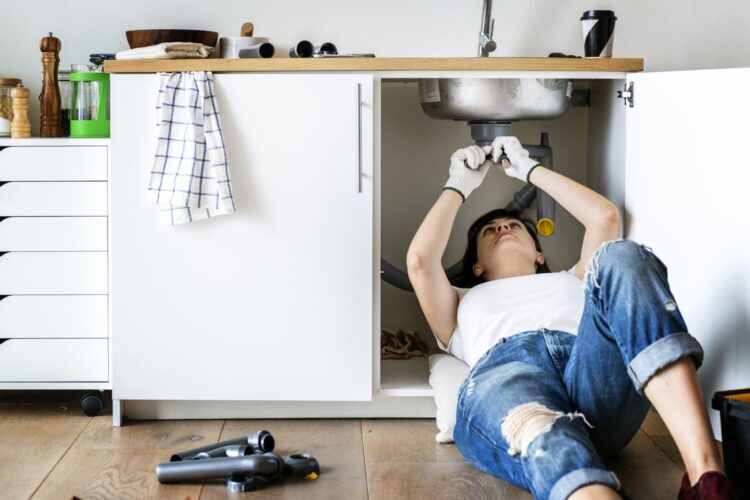
Why Regular Maintenance is Important to Keep Your Home Clean and Healthy
Regular maintenance is essential for keeping your home clean, healthy, and functioning properly. By scheduling regular maintenance tasks, you can prevent small problems from turning into big ones and avoid costly repairs down the road. Additionally, regular maintenance helps to extend the lifespan of your appliances and systems by keeping them in good working order.
One key area of regular maintenance is checking your HVAC system. Changing air filters regularly will help keep the air in your home clean and healthy while also helping to prevent issues with the system itself.
It’s also important to have your HVAC system serviced by a professional at least once a year to ensure that it’s running efficiently and safely. Another important aspect of regular maintenance is cleaning out gutters and downspouts.
Clogged gutters can lead to water damage on your roof or siding, which can be expensive to repair. Additionally, standing water in gutters is a breeding ground for the Aedes mosquitoes responsible for causing Dengue fever. Other insects and pests can also make their way into your home.
Tips for Maintaining Your Home
There are many different tasks that fall under the category of “regular maintenance.” Here are some tips for maintaining various areas of your home:
- Kitchen ─ Clean out the refrigerator every 3-6 months, wiping down shelves and checking expiration dates on food items.
Run a cleaning cycle on your dishwasher once a month.
- Bathroom ─ Check caulk around tubs and sinks every few months; if it’s cracked or peeling away, remove it and reapply new caulk.
- Flooring ─ Vacuum carpets regularly (ideally once a week) to prevent dirt from getting ground in; mop hard floors once a week or as needed.
- Exterior ─ Trim back overgrown shrubs or tree branches near your home’s exterior; check siding for signs of damage or wear and tear.
Remember that regular maintenance is ongoing, so create a schedule that works for you and stick to it. By keeping up with these tasks, you can help ensure that your home remains clean, healthy, and functional for years to come.
Conclusion
Keeping your home clean and healthy can seem like a daunting task, but by following these six strategies – regular cleaning schedules, green cleaning products, deep cleaning techniques, air quality improvement, decluttering, and regular maintenance – it’s possible to create a truly healthy home environment.
Remember that small changes can make a big difference over time. Even something as simple as switching to green cleaning products or scheduling a deep cleaning can have positive impacts on your health and well-being.
By taking care of your home and creating a space that’s both functional and comfortable, you’ll be setting yourself up for success in all areas of your life.
 Hi Boox Popular Magazine 2024
Hi Boox Popular Magazine 2024
